You are currently browsing the archives for the In the Barn category.
Archives
- August 2018
- July 2018
- May 2018
- April 2018
- March 2018
- December 2016
- November 2016
- October 2016
- September 2016
- August 2016
- July 2016
- June 2016
- April 2016
- March 2016
- February 2016
- January 2016
- December 2015
- October 2015
- September 2015
- August 2015
- July 2015
- June 2015
- May 2015
- April 2015
- March 2015
- November 2014
- October 2014
- March 2014
- February 2014
- January 2014
- December 2013
- November 2013
- October 2013
- August 2013
- July 2013
- June 2013
- May 2013
- April 2013
- March 2013
- February 2013
- January 2013
- December 2012
- November 2012
- October 2012
- September 2012
- August 2012
- July 2012
- June 2012
- May 2012
- April 2012
- March 2012
- February 2012
- January 2012
- December 2011
- November 2011
- October 2011
- September 2011
- August 2011
- July 2011
- June 2011
- May 2011
- April 2011
- March 2011
- February 2011
- January 2011
- December 2010
- November 2010
- October 2010
- September 2010
- August 2010
- July 2010
- June 2010
- May 2010
- April 2010
- March 2010
- February 2010
- January 2010
- December 2009
- November 2009
- October 2009
- September 2009
- August 2009
- May 2009
- April 2009
- March 2009
Archive for the ‘In the Barn’ Category
Keeping Poultry Warm during Colder Months
After months of silence I was awakened this morning by the sound of water dripping off the eves. Not just water, but – RAIN!!!
Finally, our long dry spell is broken. I stayed in bed longer than usual, nestled under layers of quilts and down comforters just listening to the soft – Ping…Ping…Plop…Kerplunk – of a steady rain as it hit whatever was below. It was a joyous sound. I laid there thinking about crockpots simmering hot with pot roasts or stews, the smell of home baked bread fresh from the oven, crackling fires casting a warm glow over our little farmhouse and days filled with much needed indoor chores.
As the sun rose, beaming just over the horizon through gray clouds, Blue (our Cochin rooster) began to sound off the coming dawn. I could hear him as he strutted around the coop. Soon the other boys chimed in and eventually the hens began cackling to be let out in the barn now devoid of lambs. (Did I mention the lambs went to the processor on Monday? No matter, we’ll have them back by weeks end nicely wrapped in freezer paper ready for whatever recipe strikes my fancy.) The farm is awake.
I’m up now, enjoying a steaming hot pot of tea and a piece of warm pumpkin bread smothered in butter. Yummy! It’s still raining – slow and steady – the kind that soaks in rather than runs off. It’s cold outside. The beginning of a cooler fall – I hope. But, the cold sends a message. It’s time to recheck the bedding in our nesting boxes and the level of litter on the coop floor. It’s time to make sure the coop is ready for what is predicted to be a colder than normal winter.
Chickens can handle remarkably cold temperatures. Some say the temperature doesn’t bother them until it gets down to -20 degrees, while others say as long as the coop is not damp or drafty they can handle even lower temps. But, I figure if I’m warm and snug why not them. So, we’ve cleaned out the nesting boxes and refilled them with a thick layer of shavings, then topped it with a layer of fresh straw. It’s really not necessary to have both kinds of bedding; we use the leftover shavings from the trailer so the hens can scratch in it all winter before it’s used for mulch or compost in the spring. The coop floor will get a nice thick layer of straw after any low spots have been filled in.
Damp or wet conditions in the coop can bring on illness. We’ll check the coop for drafty areas and shore them up; and we’ll minimize the ventilation to 1) lessen the amount of cold air entering the coop, and 2) reduce the openings that might appeal to predators fixed on an easy winter meal. Fox, weasel, raccoon and rodents can be surprisingly cunning if a free meal is to be had. A warming mat is set under the water trough so it won’t freeze over should the temps drop that low. And a few heat lamps will be hung just in case.
I rarely have to be concerned with frostbite, but many who live in really cold areas will. Combs, wattles and feet are susceptible to frostbite in extreme weather. A rooster whose comb freezes is not only in a lot of pain but may also be less fertile. An old-timers trick is to put petroleum jelly or Vaseline on the comb and waddles for protection. And, keeping outside poultry areas free from snow will also help. But, the number one way to keep a coop warm enough to weather most winters is a thick layer of straw because it helps hold the heat in.
On Saturday I’ll swing by the feed store and pick up a bag of corn based scratch. It won’t replace our regular chicken feed; it’s a treat the girls love, plus the added energy used to digest the corn helps keep them warm.
The seasons are a changing, folks! Fall is here. And, there’ll be pot roast and warm homemade bread for dinner tonight, a crackling fire in the fireplace and pumpkin spice candles flickering from every corner. I am one contented farmgirl.
Pulling Pigs & Small Hands
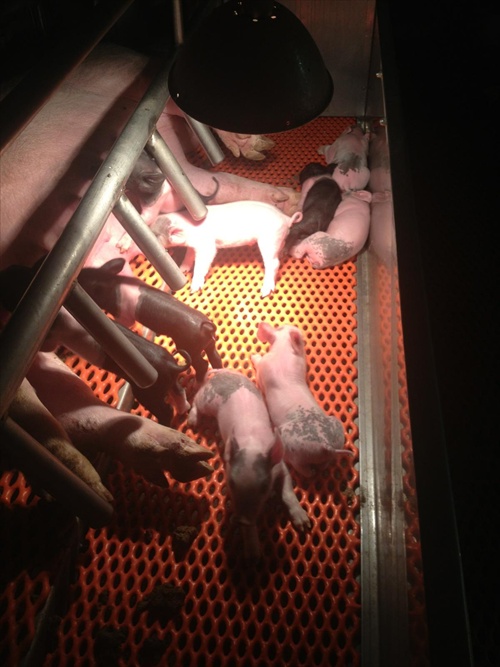 Brianne has always been a little snippet of a girl. At 5’3” she barely tops the scale at 105 pounds. I tease her that if it weren’t for her hair (long and thick) she wouldn’t even weigh 100 pounds. But, her size has never stopped her.
Brianne has always been a little snippet of a girl. At 5’3” she barely tops the scale at 105 pounds. I tease her that if it weren’t for her hair (long and thick) she wouldn’t even weigh 100 pounds. But, her size has never stopped her.
In high school she played volleyball. And in 4-H she raised meat rabbits & meat chickens, show chickens and market lambs. The work that goes into all those animals is the same whether you are an adult or a child. Most people thought it was me who did all the work while Brianne waltzed into the show ring having done nothing. But, nothing could be farther from the truth. She was the one up at 6am feeding and watering before getting ready for school and she was the one who cleaned pens, hauled feed, packed the trailer and groomed animals for shows. And, she did it for 15 years.
Now in college, she has become one of the worker-bees of her college Ag Dept. From doing paperwork to mucking out barns she is becoming a solid farm girl. But, what she is really prized for, and we have to laugh, is her thin arms and tiny hands. Why you may ask? Well—when it’s time to pull babies, of any kind, it’s easier if you have small arms and hands.
Think about it…who do you think a sow or a ewe would rather have reaching inside them pulling their baby? A twenty something guy or a petit young lady with small arms.
That’s what she did this past weekend…pull baby pigs. The swine unit at her college is in full swing farrowing sows and Brianne was right in the thick of things as several first time gilts had difficulty delivering their piglets. She says it’s sometimes painful because baby pigs nibble on your fingers when you try to pull them where as baby lambs suck on your fingers…if they can get a hold of them.
So while most college students are partying till dawn on the weekends, my kid is successfully pulling babies. All I can say is “you go girl”. What a great way to learn and get experience in preparation for having her own farm one day.
The litter pictured above is one she helped deliver on Saturday night.
Breakfast in a Basket
A quick trip into the garden gave me the beginnings of a summer frittata. Now all I have to add is a few herbs, a slice of toast with homemade blueberry jam, some country style sausage made last fall and I’ll have a breakfast fit for a farm girl with a full day worth of work ahead of her.
Poultry Processing at Mother Earth Fair
Check out this video on how to process poultry, from the 2012 Mother Earth Fair. It’s a great introduction to coming full circle raising your own meat chickens. Wish I could attend this year. looks like a wonderful line up.
Hens eating their eggs? There is a reason.
One of the worst habits a hen can develop is eating eggs, whether your flock is for egg sales or just supplying your family. And, when she gets the taste of eggs it’s hard to stop her without persistence. But, don’t panic because it’s not always necessary to cull the offending egg eater.
Egg eating usually starts by accident, when a hen steps on or accidently cracks an egg. She pokes around, tasting something yummy inside and then goes hog wild breaking and eating eggs as soon as they’re laid. Many times the whole flock joins in the feast, leaving few whole eggs for family or farm.
The reasons behind eating eggs:
- Not Enough Calcium. When hens don’t get enough calcium their shells are not strong enough to withstand everyday life in the coop. Even minor bumps or knocks can cause an egg to crack. Commercial poultry feed don’t always give your girls enough of the mineral to produce a strong shell. Supplementing with crushed oyster shells or ground egg shells can help increase the calcium level. That’s right! Eggshells for the egg eater. But, make sure they are crushed or chopped fine so the hens won’t make the connection.
- Shallow Bedding. To give hens and eggs a good soft place to land make sure there is about 2” to 3” of bedding material, like shavings or straw, in each nesting box. Less bedding means hens are laying eggs on a hard surface, which can cause cracking. I have used both for years and prefer straw in the warmer months because it doesn’t pack down as much. But, in the winter I use a layer of shavings with straw on top, giving the girls added warmth in each box. Be sure to save or compost when you clean your boxes. All that dry matter and manure makes great compost material or side dressing for nitrogen loving plants.
- Not Enough Nesting Boxes. Your coop should have one nesting box for every four or five hens. They won’t hang a shingle out claiming a specific box as their own and you may find that they use a few of the same boxes, but more boxes gives them room spread out and can cut down on the skirmishes.
- Broody Hens. When a hen is broody or setting eggs she will stand her ground, trying to keep other hens off the nest. These tussles can cause broken eggs.
- Egg Collecting Times. Leaving eggs in the nest long after they are laid is an invitation to an egg eater. Eggs should be collected shortly after they are laid, if possible. This has always been a challenge on our farm because by the time hens lay we are off at work or school, leaving collecting until evening.
- Protein Deficient. Chickens require a high percentage of protein in their diet either from feed or other sources, and the lack of it can cause hens to crave eggs. So…give them what they want! Strange I know, but one source of protein can be eggs. That’s right, eggs. Adding a bit of scrambled eggs to their feed can help fill the protein gap.
- Lack of Privacy. Or, in this case “out of sight, out of mind”. If hens can’t see the eggs they are less likely to explore the nest. Draping the front of the nesting boxes can help.
A few other reasons hens will eat eggs is boredom and a lack of things to do. Give your hens a place to roost outside where they can watch the world, piles of leaves to scratch in provide hours of amusement, and hanging treats in a tree to occupy them.
Playing tricks on your hens can also help stop existing egg eaters.
Replace eggs with “fake” eggs like plastic, wood or ceramic, golf balls, or ping pong balls; anything small and round. When your hens go to peck these “eggs” they won’t break, nor will they find anything tasty inside.
Blow out a real chicken egg and refill it with something that won’t taste good like mustard or hot sauce. They’ll get the message that eggs are not good.
Hang curtains in front of nesting boxes to block the egg eater’s view. If they can’t see the eggs they won’t eat the eggs.
With a little creativity and trickery you can work your hens out of eating eggs instead of culling them.
The Color of Breakfast & The Promise of Fall
The little flock of hens are in full production, laying a half dozen eggs a day. Even the new additions from early spring have begun to lay. Ever since we stopped showing chickens egg production around our farm has been all about egg color. With Cochins, Wyndottes, Americanas and Sussex we get blue/green, light brown, dark brown and what my neighbor calls “pink” eggs. But, they’re all the same scrambled with ham and cheese, baked into a quiche with fresh picked spinach, mixed into our latest baking project or made into egg salad–Wonderful! Flavorful! Better than any store bought egg could ever dream of being.
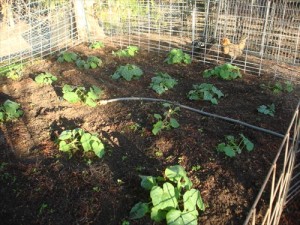
Pumpkin and squash seeds started in 4-inch pots back in the cooler months of early spring were planted out a few weeks ago and now our pumpkin patch is poised to exploded with runners and flowers and newly set fruit. There is Sugar Pie for pies and pumpkin butter, Connecticut Field for carving and decoration, Cinderella for looks, and Butternut, Sweet Dumpling and Delicata squash for baking with amber maple syrup, brown sugar and cinnamon, or stewing in a savory Moroccan Lamb Tagine.
Life on a summer farm is lived in the moment, but we never loose sight of what’s to come. We’ll enjoy the freshness of the garden and barn today while dreaming of that crisp fall day when pumpkins will adorn the front walk and the aroma of fresh baked pumpkin bread will fill the house.
Now that’s a fair promise for ya!
Banana Pecan Pancakes
I’m a big fan of using small bits of most anything to make hearty well balanced meals.—big fan. So much of what people leave behind in the fridge goes to waste when just a bit of creative energy can turn those bits into a wonderfully satisfying meal. Case in point — last night, when I was cleaning the kitchen I realized that my banana was getting too soft to eat. Usually I make banana bread out of the soft ones, but with my life as an empty nester a loaf of banana bread is too much for one person. My solution…turn that lone tropical fruit into a small batch of banana pancakes, with some help from a small amount of pecans I had in the freezer. Simple.
After mixing up a batch of pancake batter for one I mashed the banana, chopped a ¼ cup of pecans and threw it all into the bowl. Once that thick batter hit the hot griddle the kitchen smelled amazing; warm and inviting and comforting like an early fall morn. When my stack of pancakes came off the griddle I slathered them with butter and drizzled warm Vermont maple syrup over the top; added a few slices of crispy bacon and a sliced apple, and there it was—dinner. There’s nothing like the tantalizing smell of breakfast for dinner to turn your head away from the day and bring you solidly into the easy flow of a relaxing night. Perfect.
What little bits are looming in your fridge that can be made into a wonderful meal like a quiche, frittata, stew, soup or chopped to top a hearty salad? Be creative and eat well!
Checking Off Homesteading Skills
I saw this list of 101 homesteading skills and thought it would be fun to see how many of them I already knew how to do. After reading it over and checking them off I was surprised at how many I already use or knew how to do. It also gave me a good list of new skills to learn. Not all of them will pertain to a suburban homestead, but the list would be a good stating point for anyone trying to improve their knowledge of homesteading. And, I’m sure if we put our minds to it we could come up with 1001 things a homesteader should know.
Just for fun see how many you already know then make plans to learn a few new ones in 2013!
1. to use a chainsaw safely
√ to grow a vegetables & herbs
√ to sharpen an edged tool – knife, axe, hoe, chisel etc.
√ to use and store firearms safety
√ to tan rabbit skins
6. to read the weather
7. to spin wool, cotton or angora into thread or yarn using a spinning wheel or drop spindle
√ to use long handles tools without hurting your back
√ to light a fire indoors or outdoors
√ to buy at an auction without paying too much
√ to mend clothes
√ to butcher rabbits or chickens
√ to hang clothes on a clothesline
√ to operate & maintain a tiller
15. the unique traits of different trees & their types of wood
√ to cook from scratch
17. to pasteurize milk
√ to conserve & save water
√ to recognize healthy plants & animals versus unhealthy
√ basic sewing skills
√ to ear tag or tattoo an animal
√ to tell an animal’s age by its teeth
23. to replace a broken window
√ to drive a stick shift
25. Learn how to thaw out frozen pipes without busting them
√ to graft a fruit tree
27. to hand thresh & winnow wheat or oats & other small grains
28. to train a working cattle or sheep dog
29. to read the moon and stars
√ to make cheese
√ to live within your means
√ to catch, clean & fillet a fish
33. to use a wash tub, hand-wringer and washboard
√ to make soap or detergent
√ to build a bunk planter
√ to can canning & preserve food
√ to save seeds
√ to de-horn livestock
√ basic leather work or repair
√ to plan for the future – orchard, livestock program, or energy sources
√ to repair with duct tape, baling twine or whatever is on hand
√ to read an almanac
√ to put down an animal
√ to cook on an open fire
√ entertain yourself without electronic media
√ to shear a sheep, electric & hand
√ to maintain shears
√ to swap, barter and network with like-minded people
√ to make candles
50. to dig & use a shallow well
√ to refinish furniture
52. to drive a draft animal
√ to realistically deal with life, death and failure
√ to use & maintain an oil lamp
√ to treat livestock injuries
√ to restrain large livestock
√ to use a sewing machine
√ to give an IM or Sub-Q injection
√ to properly use hand tools
√ to recognize your own physical and mental limits
√ how and when to prune grapes and fruit trees
√ to hatch out eggs
63. to use a scythe
64. to skin a furred animal & stretch the skin
65. to tell the time of day by the sun
√ to milk a goat, sheep or cow
√ to stomach tube a newborn animal
√ to butcher large livestock
√ to use a wood stove & to bank a fire
√ to make butter
71. to knit or crochet
√ to make & use a hot bed or cold frame
√ to deliver a piglet, calf, lamb or goat
74. to know when winter is over
√ to plant a tree
√ to brood day-old chicks
77. to dye yarn or cloth from plants
√ to haggle like a horse trader
√ to bake bread from scratch
80. to use a pressure tank garden sprayer
√ to halter break a horse, cow, sheep or goat
√ to graft baby animals onto a foster-mother
83. to weave cloth
√ to grow kitchen herbs
√ to make sausage
√ to set and bait traps for unwanted vermin and predators
√ to grind wheat into flour
88. to make paper and ink
89. to learn when it is more economical to buy ready-made or make it yourself
√ to castrate large livestock
√ to choose a location for a vegetable garden or orchard
92. to weave a basket
93. to use electric netting or fencing
√ to make fire starters
95. to use a pressure cooker
96. to correctly attach 3 point hitch implements to a tractor
√ to trim hooves of goats or sheep
√ to sew a quilt
99. to make wine or beer
√ basic plumbing & electrical
√ to shoot a rifle & handgun
73 down
28 to go!
Not bad. Not bad at all!!
The Great Chicken Debate – Cornish Rock Crosses vs. Heritage Breeds
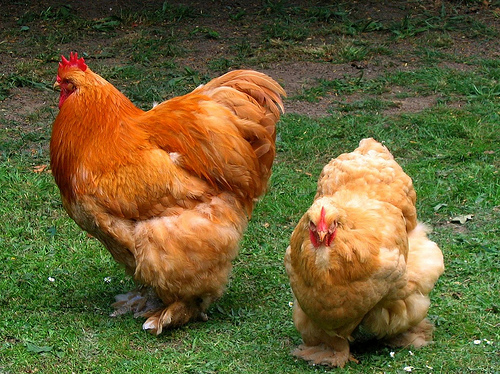
Today’s grocery store chickens are hybridized to be exactly the same as all the other grocery store chickens. They are bred to grow the same, finish out the same and be similar in weight. This fast-growing breed is called a Cornish Rock Cross. Typically, they range in age from 4-weeks, for a Cornish Game Hen, to 8 to 10 weeks for a full grown roaster. The chickens are the same; only their name has been changed, taking labels given to chickens from days gone by.
So, if you’re thinking that a Cornish Game hen is not a Cornish Game hen at all, but rather a baby Cornish Rock Cross, you’d be right. Cornish Game hens are not raised commercially any longer because they take too long to grow to a marketable weight.
Modern grocery store chickens also have white feathers and were developed in the 1980’s to gain weight fast on a limited amount of feed. It is true that some birds grow so fast that they sometimes have heart attacks or break down in their legs before ever reaching a butcherable weight. But, I think that is a factor in commercially raised birds more than homestead or small farm raised birds. Some growers even limit the feeding schedule to slow down the birds’ growth.
And, what about those white feathers? Well—the average consumer wants a pretty carcass to make a pretty roasted chicken to put on her family’s dinner table. Non-white feathered chickens can have black spots in the skin where the pin feathers broke off during plucking. This happens to white chickens too; only the consumer can’t see them because they are white. Read the rest of the story »
Newest Arrivals
Our flock of chickens grew this week. Four new arrivals, 2 Welsummer and 2 Blue Wyandotte pullets were added to the coop. I hadn’t really planned on adding more hens this early, but when I realized some of my girls were getting on in years, slowing down their egg production, and my friend and chicken breeder Larry had 3-month old’s in the breeds I was thinking about, the plan sped up by a few months.
I’ve never really been interested in the plain production breeds like Leghorns, Barred Rocks or Rhode Island Reds. I want hens that are colorful, not only in their feathers, but also in their eggs. I already have Americana’s that lay blue-green eggs, and Black Cochin’s and New Hampshire’s that lay light brown eggs. The only thing missing was a breed that lays the dark chocolate brown eggs, like those Cadbury chocolates wrapped in shiny gold paper.
There are only two breeds that lay such dark brown eggs—Marans and Welsummer’s. Marans tend to be a little pricey for egg layers and relatively hard to come by, but Welsummer’s are more common. They are a Dutch breed…a combination of several breeds really. But, over time they have been refined and standardized by poultry breeders who took a fancy to them as soon as they were imported. Through selective breeding they have become a nice temperate addition to farm flocks, and the dark brown eggs they lay are an added bonus.
(Welsummer hens)
The Blue Wyandotte is a variety of the Wyandotte breed, meaning they are a “color” of the breed. Wyandotte’s come in a several different colors from golden and silver laced, to white, black and buff. There are even Columbian, partridge and silver penciled giving any poultry lover a wide range of colors and feather patterns to choose from.
Wyandotte’s are an American breed used for both egg production and meat. Although I like them for their solid medium brown eggs, I also think they are just what a chicken should be…plump, fluffy and fun to watch scratching in the garden.
(Blue Wyandotte Hen)
Right now they are housed in six foot long wire caged that was used when we raised meat rabbits. The cage will keep them safe at this young age, away from circling hawks and feral cats, and allow the other chickens to get use to new additions. Although I don’t think Sophia (our goose) is to keen on the idea of more chickens in the coop.
So…in a few months the flock will add a wonderful dark brown color to my daily collection of farm fresh eggs.
Breakfast can’t get any better than that!
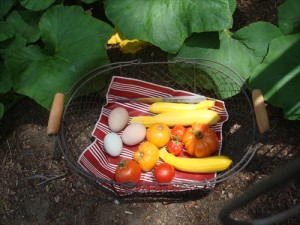
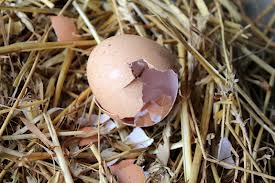
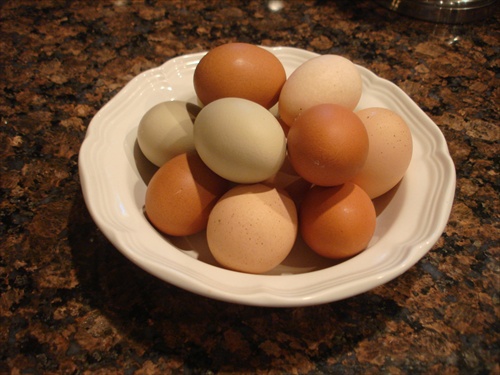

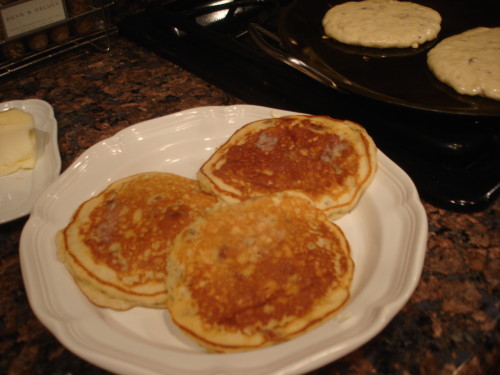
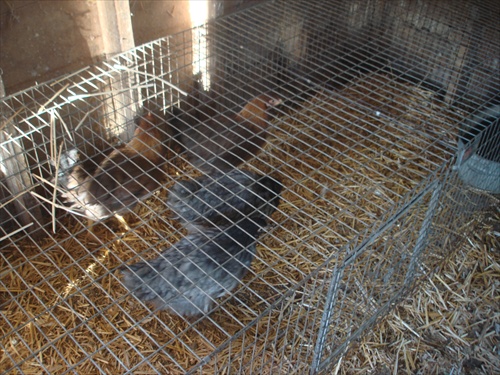
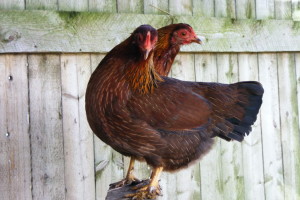
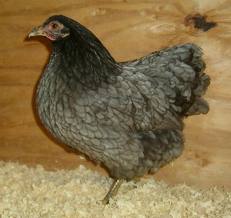
Recent comments
Aenean nonummy hendrerit mauris. Phasellus porta.